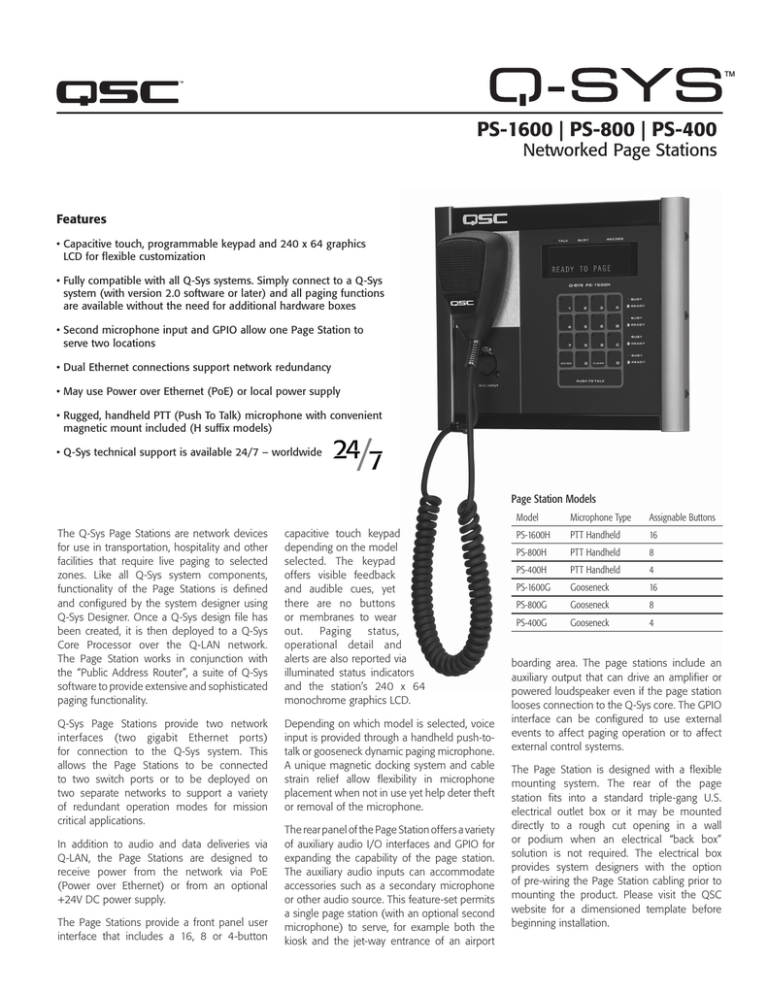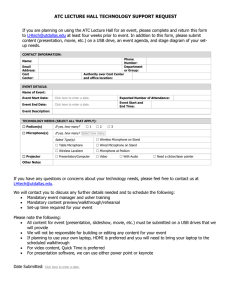
™
PS-1600 | PS-800 | PS-400
Networked Page Stations
Features
•C
apacitive touch, programmable keypad and 240 x 64 graphics
LCD for flexible customization
• F ully compatible with all Q-Sys systems. Simply connect to a Q-Sys
system (with version 2.0 software or later) and all paging functions
are available without the need for additional hardware boxes
•S
econd microphone input and GPIO allow one Page Station to
serve two locations
• Dual Ethernet connections support network redundancy
• May use Power over Ethernet (PoE) or local power supply
•R
ugged, handheld PTT (Push To Talk) microphone with convenient
magnetic mount included (H suffix models)
• Q -Sys technical support is available 24/7 – worldwide
Page Station Models
The Q‑Sys Page Stations are network devices
for use in transportation, hospitality and other
facilities that require live paging to selected
zones. Like all Q‑Sys system components,
functionality of the Page Stations is defined
and configured by the system designer using
Q‑Sys Designer. Once a Q‑Sys design file has
been created, it is then deployed to a Q‑Sys
Core Processor over the Q‑LAN network.
The Page Station works in conjunction with
the “Public Address Router”, a suite of Q‑Sys
software to provide extensive and sophisticated
paging functionality.
capacitive touch keypad
depending on the model
selected. The keypad
offers visible feedback
and audible cues, yet
there are no buttons
or membranes to wear
out.
Paging
status,
operational detail and
alerts are also reported via
illuminated status indicators
and the station’s 240 x 64
monochrome graphics LCD.
Q‑Sys Page Stations provide two network
interfaces (two gigabit Ethernet ports)
for connection to the Q‑Sys system. This
allows the Page Stations to be connected
to two switch ports or to be deployed on
two separate networks to support a variety
of redundant operation modes for mission
critical applications.
Depending on which model is selected, voice
input is provided through a handheld push-totalk or gooseneck dynamic paging microphone.
A unique magnetic docking system and cable
strain relief allow flexibility in microphone
placement when not in use yet help deter theft
or removal of the microphone.
In addition to audio and data deliveries via
Q‑LAN, the Page Stations are designed to
receive power from the network via PoE
(Power over Ethernet) or from an optional
+24V DC power supply.
The Page Stations provide a front panel user
interface that includes a 16, 8 or 4-button
The rear panel of the Page Station offers a variety
of auxiliary audio I/O interfaces and GPIO for
expanding the capability of the page station.
The auxiliary audio inputs can accommodate
accessories such as a secondary microphone
or other audio source. This feature-set permits
a single page station (with an optional second
microphone) to serve, for example both the
kiosk and the jet‑way entrance of an airport
Model
Microphone Type
Assignable Buttons
PS-1600H
PTT Handheld
16
PS-800H
PTT Handheld
8
PS-400H
PTT Handheld
4
PS-1600G
Gooseneck
16
PS-800G
Gooseneck
8
PS-400G
Gooseneck
4
boarding area. The page stations include an
auxiliary output that can drive an amplifier or
powered loudspeaker even if the page station
looses connection to the Q‑Sys core. The GPIO
interface can be configured to use external
events to affect paging operation or to affect
external control systems.
The Page Station is designed with a flexible
mounting system. The rear of the page
station fits into a standard triple-gang U.S.
electrical outlet box or it may be mounted
directly to a rough cut opening in a wall
or podium when an electrical “back box”
solution is not required. The electrical box
provides system designers with the option
of pre-wiring the Page Station cabling prior to
mounting the product. Please visit the QSC
website for a dimensioned template before
beginning installation.
Q-Sys Public Address Functionality
Preliminary Specifications
Q-Sys Designer (version 2.0 and higher) includes the Public
Address Router, a suite of functions to support public
address applications. Most of these functions may be
deployed whether or not the Q-Sys system incorporates QSC
page stations. Alternative interfaces such as touch screen
controllers may also be used in conjunction with analog
microphones. All of these functions are executed by the Q-Sys
core with no additional hardware “boxes” required.
Audio Channel Capacity
2 line inputs, 1 line output
Front Panel Controls
Paging Keypad: Capacitive touch keypad
Microphone: PTT momentary switch (“H” models only)
Front Panel Indicators
Talk, Ready, Busy: Bi-color LEDs (red/green)
Keypad button activity: Green LEDs
LCD: 240 x 64 monochrome graphics display
Front Panel Connectors
“H” Models: RJ45 microphone connector
“G” Models: XLR microphone connector
Local backup paging (requires local amplification &
loudspeaker) permits the station to function locally even if
the core and network become unavailable.
Rear Panel Connectors
Q-Sys Network LAN A: RJ45 1000 Mbps only
Q-Sys Network LAN B: RJ45 1000 Mbps only
DC power +24V inlet: 2-pin Euro receptacle
Line input: 3-pin Euro receptacle
Line output: 3-pin Euro receptacle
GPIO: 6-pin Euro receptacle
Line Voltage Requirements
IEEE 802.3af power over Ethernet (POE) or +24V DC
Dimensions (HWD)
10.37" (26.4 cm) x 8.3" (21.1 cm) x 1.5" (3.8 cm)
Accessories Included
Hardware user manual, software CD, connector ship kit,
warranty card and one of the following: PTT handheld microphone (“H” models) or gooseneck microphone (“G” models)
Virtual Page Station supports the design of custom graphic or
physical page station interfaces. It is used in conjunction with
a microphone connected to an analog input and can support
any number of preset page events or allow the user to create
ad-hoc destination Zone Groups, etc.
The Design Administration Interface is provided to allow facility
personnel to manage day to day changes to selected system
settings without accessing the system design. Functions
including security code changes, station / zone assignments
and scheduling of pre-recorded messages may be made
available to facility staff
The core provides a SIP-VoIP (Session Initiation Protocol)
telephone interface to allow VoIP based telephony to act
as a page station or to trigger various other functions. Voice
prompts and pre-recorded message creation are supported.
A variety of Paging Logic functions are supported including:
• Source to zone routing
• Priority and interruption logic
• Queuing logic
• Page delay
• Preambles (such as chimes)
• Emergency paging priority and over-ride logic
Messaging capability includes the ability to record
announcements and trigger playback of pre-recorded
announcements. Multi-layer security is provided with passcode access. A sophisticated Event Scheduler is provided that
can be used to schedule pre-recorded announcements or to
make changes to system parameters at pre-specified times.
Line Input
Dynamic Range
Unweighted
A-weighted
> 115 dB
> 118 dB
Distortion (20 Hz - 20 kHz, all
sensitivities)
+4 dBu (max)
2 dB below clip
< 0.009% THD+N
< 0.009% THD+N
Crosstalk (20 Hz - 20 kHz)
Inter-channel (max)
Inter-channel (typical)
Intra-channel (max)
Intra-channel (typical)
> 75 dB
> 90 dB
> 85 dB
> 100 dB
Frequency Response
20 Hz - 20 kHz (max)
20 Hz - 20 kHz (typical)
± 0.5 dB
± 0.2 dB
Input Impedance
Balanced (nominal)
Unbalanced (nominal)
10k ohms
10k ohms
Common Mode Rejection
20 Hz - 20 kHz (max)
20 Hz - 20 kHz (typical)
> 54 dB
> 60 dB
Input Sensitivities
Vrms: 1.5, 3, 9, 18
dBu: 5.7, 11.8, 21.3, 27.3
dBv: 3.5, 9.5, 19.1, 25.1
Line Output
Dynamic Range
Unweighted
A-weighted
> 112 dB
> 115 dB
Crosstalk (20 Hz - 20 kHz)
Inter-channel (max)
Inter-channel (typical)
Intra-channel (max)
Intra-channel (typical)
> 75 dB
> 90 dB
> 85 dB
> 100 dB
Mute
Infinite attenuation
Specifications subject to change without notice.
please recycle
©2008, 2009, 2010 QSC Audio Products, LLC. All rights reserved. QSC and the QSC logo are registered trademarks of QSC Audio Products, LLC in the U.S. Patent and
Trademark office and other countries. Q-Sys, Q-LAN, Q-Sys Core Processor, Q-Sys Core 1000, Q-Sys Core 3000, Q-Sys Core 4000, Q-Sys I/O Frame, Q-Sys PS-1600H,
Q-Sys Page Station and Q-Sys Designer are trademarks of QSC Audio Products, LLC. “QSC” and the QSC logo are registered with the U.S. Patent and Trademark Office.
1675 MacArthur Boulevard • Costa Mesa, CA 92626 • Ph: 800/854-4079 or 714/957-7100 • Fax: 714/754-6174
PageStation Spec Sheet - 05/27/10
qscaudio.com



